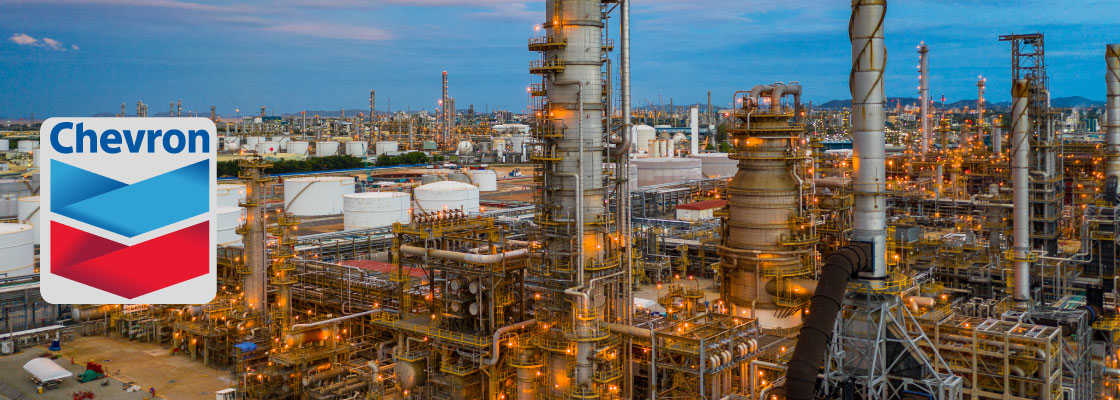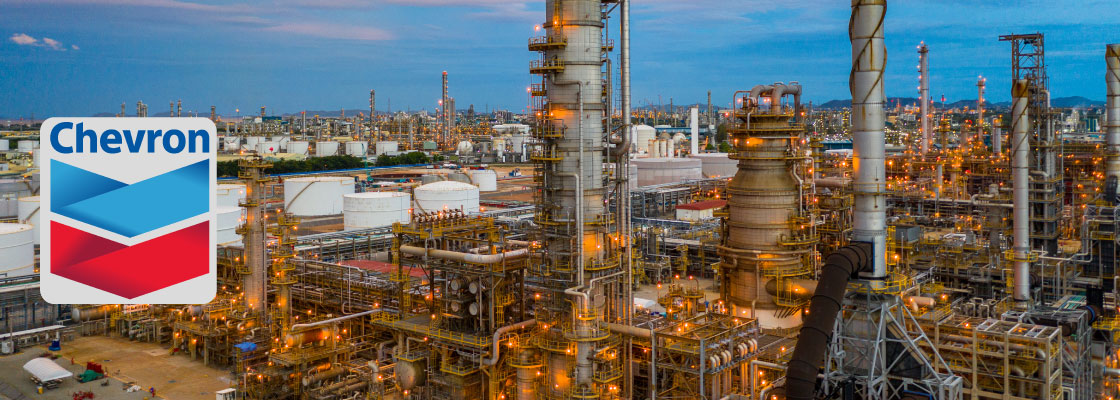Chevron Corporation's Strong Q3 Financial Performance

- Chevron Corporation (NYSE:CVX) exceeded earnings and revenue forecasts in Q3, showcasing its resilience in the energy sector.
- The company's strategy of reducing costs and boosting oil production, especially in the Permian Basin, has been effective.
- Chevron's solid financial metrics, including a low debt-to-equity ratio and high earnings yield, indicate a strong financial standing.
Chevron Corporation (NYSE:CVX) recently reported its third-quarter earnings, showcasing a strong financial performance. The company reported earnings per share of $2.51, surpassing the estimated $2.43. Additionally, Chevron's revenue reached approximately $50.67 billion, exceeding the forecasted $48.86 billion. This performance highlights Chevron's ability to navigate the energy sector's challenges effectively.
During the Q3 2024 earnings call, key figures such as CEO Mike Wirth and CFO Eimear Bonner discussed Chevron's financial performance. The call, facilitated by Jake Spiering, included analysts from major institutions like Bank of America and Goldman Sachs. Chevron's strategy focuses on reducing costs and increasing oil production, particularly in the Permian Basin, which contributed to the company's strong results.
Chevron's adjusted profit for the quarter was $4.5 billion, or $2.51 per share. Although this is lower than the previous year's $5.7 billion or $3.05 per share, it still exceeded market expectations. The company's record production levels in the United States and the Permian Basin played a significant role in achieving these results, as highlighted by Bloomberg.
Chevron's financial metrics indicate a solid position in the market. The company has a price-to-earnings (P/E) ratio of approximately 14.93 and a price-to-sales ratio of about 1.43. Its enterprise value to sales ratio is around 1.53, and the enterprise value to operating cash flow ratio is approximately 8.49. These figures suggest that Chevron is efficiently managing its resources and maintaining a strong financial standing.
Chevron's debt-to-equity ratio is roughly 0.15, indicating a relatively low level of debt compared to its equity. This low debt level, combined with a current ratio of approximately 1.16, suggests that Chevron has a good level of liquidity to cover its short-term liabilities. The company's earnings yield of about 6.70% further underscores its financial health and ability to generate returns for investors.
| Symbol | Price | %chg |
|---|---|---|
| YPFD.BA | 54775 | -0.18 |
| XOM.MX | 2111 | -0.9 |
| TGSU2.BA | 9400 | -2.93 |
| 2222.SR | 25.9 | 0 |

Chevron Corporation's Strategic Initiatives and Market Performance
- Scotiabank maintains a "Sector Perform" rating for Chevron Corporation (NYSE:CVX), with a raised price target from $160 to $165.
- The inauguration of the Engineering and Innovation Excellence Center (ENGINE) in Bengaluru, India, aims to boost Chevron's digital and artificial intelligence capabilities.
- Despite positive developments, Chevron's stock price has seen a slight decrease, with a current price of $152.55, indicating some market volatility.
Chevron Corporation (NYSE:CVX), a major player in the global energy sector, is involved in various activities, including oil and gas exploration, production, refining, and marketing. Competing with other energy giants like ExxonMobil and BP, Chevron has been a focus for investors. On October 9, 2025, Scotiabank maintained its "Sector Perform" rating for Chevron, suggesting investors hold onto their shares. At that time, Chevron's stock was priced at $152.57.
Scotiabank also raised Chevron's price target from $160 to $165, indicating a positive outlook for the company's future performance. This adjustment reflects confidence in Chevron's strategic initiatives, such as the recent inauguration of a 312,000-square-foot facility in Bengaluru, India. This facility, known as the Engineering and Innovation Excellence Center (ENGINE), aims to enhance Chevron's digital and artificial intelligence capabilities.
Despite the positive developments, Chevron's stock price has seen a slight decrease. The current price is $152.55, down approximately 0.78% with a change of $1.19. Today, the stock has fluctuated between $152.24 and $154.93. Over the past year, Chevron's stock has experienced a high of $168.96 and a low of $132.04, indicating some volatility in its market performance.
Chevron's market capitalization stands at approximately $307.36 billion, reflecting its significant presence in the energy sector. The trading volume for CVX is 1,509,507 shares, suggesting active investor interest. As Chevron continues to expand its technical operations and digital capabilities, investors will be keen to see how these initiatives impact the company's financial performance and stock value.

Chevron Corporation (NYSE:CVX) Maintains Strong Position Amidst Industry Challenges
- Wells Fargo reaffirms an "Overweight" rating for Chevron Corporation (NYSE:CVX), indicating confidence in its long-term prospects despite a forecasted decrease in earnings.
- Analysts project a decline in Chevron's Q2 earnings to $1.75 per share from $2.55 per share the previous year, reflecting broader energy sector challenges.
- Despite an anticipated drop in quarterly revenue to $45.59 billion from $51.18 billion, Chevron's significant market presence and resolution of disputes with Exxon Mobil suggest potential for future growth.
Chevron Corporation (NYSE:CVX) is a major player in the global energy sector, primarily involved in oil and gas exploration, production, and refining. As one of the largest integrated energy companies, Chevron competes with industry giants like Exxon Mobil and BP. On August 1, 2025, Wells Fargo reaffirmed its "Overweight" rating for Chevron, with the stock priced at $151.64, as reported by Benzinga.
Chevron is preparing to release its second-quarter earnings on August 1, 2025. Analysts expect a decrease in earnings, forecasting $1.75 per share compared to $2.55 per share in the same period last year. This anticipated decline in earnings reflects broader challenges in the energy sector, impacting Chevron's financial performance.
The company's quarterly revenue is projected to be $45.59 billion, down from $51.18 billion a year earlier. This decline in revenue aligns with the expected drop in earnings, indicating potential challenges in Chevron's operations or market conditions. Despite these projections, Wells Fargo's "Overweight" rating suggests confidence in Chevron's long-term prospects.
Recently, Chevron's stock experienced a 1.3% drop, closing at $151.64. The stock has traded between $151.14 and $153.93 today, with a 52-week high of $168.96 and a low of $132.04. Chevron's market capitalization is approximately $310.47 billion, reflecting its significant presence in the energy industry.
Chevron has also resolved a dispute with Exxon Mobil over Hess Corp, which could positively impact its operations and investor sentiment. The trading volume for CVX on the NYSE is 6,964,095 shares, indicating active investor interest. Despite current challenges, Chevron remains a key player in the energy sector, with potential for future growth.

Chevron Corporation's Upcoming Earnings Report: A Detailed Analysis
- Chevron Corporation (NYSE:CVX) is set to release its quarterly earnings with an expected EPS of $1.66 and projected revenues of $45 billion.
- The anticipated EPS represents a 34.9% decline year-over-year, yet there's a positive revision of 14.4% in the EPS estimate over the past 30 days.
- Despite a projected revenue decline of 7.9% year-over-year, improvements in natural gas pricing and U.S. output, along with an increase in downstream income to $631 million, could stabilize Chevron's financial performance.
Chevron Corporation, listed as NYSE:CVX, is a major player in the global energy sector, primarily involved in oil and gas exploration, production, and refining. As it prepares to release its quarterly earnings on August 1, 2025, analysts have set expectations for an earnings per share (EPS) of $1.66 and projected revenues of $45 billion.
Despite the anticipated EPS of $1.66, this figure represents a 34.9% decline from the same period last year. This decline is significant, especially in the context of Chevron's historical performance. However, the consensus EPS estimate has been revised upward by 14.4% in the past 30 days, indicating a potential positive shift in investor sentiment.
The company's downstream income is expected to rise to $631 million, up from $597 million in the same period last year. This increase suggests that Chevron's refining and marketing operations are performing well, despite the broader challenges in the energy sector. The company's financial metrics, such as a P/E ratio of 17.06 and a price-to-sales ratio of 1.61, provide insights into its market valuation.
Chevron's financial health is further supported by a low debt-to-equity ratio of 0.20, indicating a conservative approach to debt. Additionally, a current ratio of 1.08 suggests that Chevron is well-positioned to meet its short-term liabilities. These factors, combined with an earnings yield of 5.86%, offer a comprehensive view of Chevron's financial standing as it approaches its earnings announcement.

Chevron Corporation (NYSE:CVX) Maintains Strong Position Amid Acquisition and Market Movements
- Bank of America Securities reaffirms a "Buy" rating for Chevron, with a target price of $170, highlighting confidence in its growth potential.
- The acquisition of Hess Corporation marks a pivotal moment for Chevron, promising to enhance long-term growth and free cash flow.
- Chevron's stock demonstrates resilience and investor interest, with a market capitalization of approximately $269.24 billion and active trading volume.
Chevron Corporation (NYSE:CVX) is a major player in the global energy sector, primarily involved in oil and gas exploration, production, and refining. As of July 10, 2025, Bank of America Securities maintained a "Buy" rating for Chevron, with the stock priced at $154.19. The recommendation to "hold" suggests confidence in Chevron's potential, despite ongoing challenges.
Chevron's acquisition of Hess Corporation is a significant development, nearing resolution after nearly two years of legal disputes. This all-stock deal is crucial for Chevron's long-term growth and free cash flow prospects. The arbitration, involving claims by Exxon Mobil and CNOOC, is expected to conclude soon, potentially impacting Chevron's strategic position.
The acquisition has already cleared antitrust reviews and received shareholder approval, indicating strong support for the deal. Bank of America Securities analyst Jean Ann Salisbury maintains a Buy rating on Chevron, with a price target of $170. This reflects limited downside and substantial upside potential for the stock, which is currently priced at $154.17.
Chevron's stock has shown resilience, with a recent increase of approximately 0.75% or $1.15. The stock has traded between $151.68 and $155.28 today, demonstrating some volatility. Over the past year, CVX has reached a high of $168.96 and a low of $132.04, indicating a wide trading range.
With a market capitalization of approximately $269.24 billion, Chevron remains a formidable force in the energy sector. Today's trading volume for CVX is 8,371,790 shares, reflecting active investor interest. As the arbitration concludes, Chevron's strategic moves could further influence its market position and investor sentiment.

Chevron Corporation (NYSE:CVX) Earnings Report Analysis
- Chevron's EPS of $2.06 missed the estimated $2.42, marking a negative surprise of 5.94%.
- The company's revenue for the quarter was $52.23 billion, exceeding estimates and demonstrating strong sales performance.
- Chevron's refining business reported a loss for the first time since 2020, highlighting challenges in the industry.
Chevron Corporation (NYSE:CVX) is a major player in the oil and gas industry, known for its integrated operations spanning exploration, production, refining, and marketing. As the second-largest oil producer in the United States, Chevron competes with other industry giants like ExxonMobil and BP. The company operates globally, with a significant presence in both upstream and downstream sectors.
On January 31, 2025, Chevron reported earnings per share (EPS) of $2.06, which fell short of the estimated $2.42. This represents a negative surprise of 5.94%, as highlighted by Zacks. The EPS also marked a decline from the $3.45 reported in the same quarter the previous year. Despite this, Chevron had previously exceeded expectations in the prior quarter with an EPS of $2.51 against an anticipated $2.47.
Chevron's revenue for the quarter ending December 2024 was approximately $52.23 billion, surpassing the estimated $46.60 billion. This exceeded the Zacks Consensus Estimate by 11.21% and marked an increase from the $47.18 billion reported a year ago. Chevron has outperformed consensus revenue estimates in three of the last four quarters, demonstrating its ability to generate strong sales despite challenges.
The company's refining business faced a loss for the first time since 2020, with a $248 million loss in the fourth quarter of 2024. This was a significant drop from the $1.15 billion profit recorded in the same period a year earlier. Weak margins and reduced demand for jet fuel, particularly in the U.S., contributed to this downturn. The decline in fuel sales profits was a trend seen across the industry as economic activity slowed in major markets like the U.S. and China.
Chevron's financial metrics provide insight into its market valuation and financial health. The company has a price-to-earnings (P/E) ratio of approximately 16.87 and a price-to-sales ratio of about 1.45. Its enterprise value to sales ratio is around 1.56, and the enterprise value to operating cash flow ratio is approximately 8.57. Chevron's debt-to-equity ratio is relatively low at 0.17, indicating conservative debt usage, while its current ratio of approximately 1.07 suggests balanced liquidity.

Chevron Corporation (NYSE:CVX) Earnings Report Analysis
- Chevron's EPS of $2.06 missed the estimated $2.42, marking a negative surprise of 5.94%.
- The company's revenue for the quarter was $52.23 billion, exceeding estimates and demonstrating strong sales performance.
- Chevron's refining business reported a loss for the first time since 2020, highlighting challenges in the industry.
Chevron Corporation (NYSE:CVX) is a major player in the oil and gas industry, known for its integrated operations spanning exploration, production, refining, and marketing. As the second-largest oil producer in the United States, Chevron competes with other industry giants like ExxonMobil and BP. The company operates globally, with a significant presence in both upstream and downstream sectors.
On January 31, 2025, Chevron reported earnings per share (EPS) of $2.06, which fell short of the estimated $2.42. This represents a negative surprise of 5.94%, as highlighted by Zacks. The EPS also marked a decline from the $3.45 reported in the same quarter the previous year. Despite this, Chevron had previously exceeded expectations in the prior quarter with an EPS of $2.51 against an anticipated $2.47.
Chevron's revenue for the quarter ending December 2024 was approximately $52.23 billion, surpassing the estimated $46.60 billion. This exceeded the Zacks Consensus Estimate by 11.21% and marked an increase from the $47.18 billion reported a year ago. Chevron has outperformed consensus revenue estimates in three of the last four quarters, demonstrating its ability to generate strong sales despite challenges.
The company's refining business faced a loss for the first time since 2020, with a $248 million loss in the fourth quarter of 2024. This was a significant drop from the $1.15 billion profit recorded in the same period a year earlier. Weak margins and reduced demand for jet fuel, particularly in the U.S., contributed to this downturn. The decline in fuel sales profits was a trend seen across the industry as economic activity slowed in major markets like the U.S. and China.
Chevron's financial metrics provide insight into its market valuation and financial health. The company has a price-to-earnings (P/E) ratio of approximately 16.87 and a price-to-sales ratio of about 1.45. Its enterprise value to sales ratio is around 1.56, and the enterprise value to operating cash flow ratio is approximately 8.57. Chevron's debt-to-equity ratio is relatively low at 0.17, indicating conservative debt usage, while its current ratio of approximately 1.07 suggests balanced liquidity.







